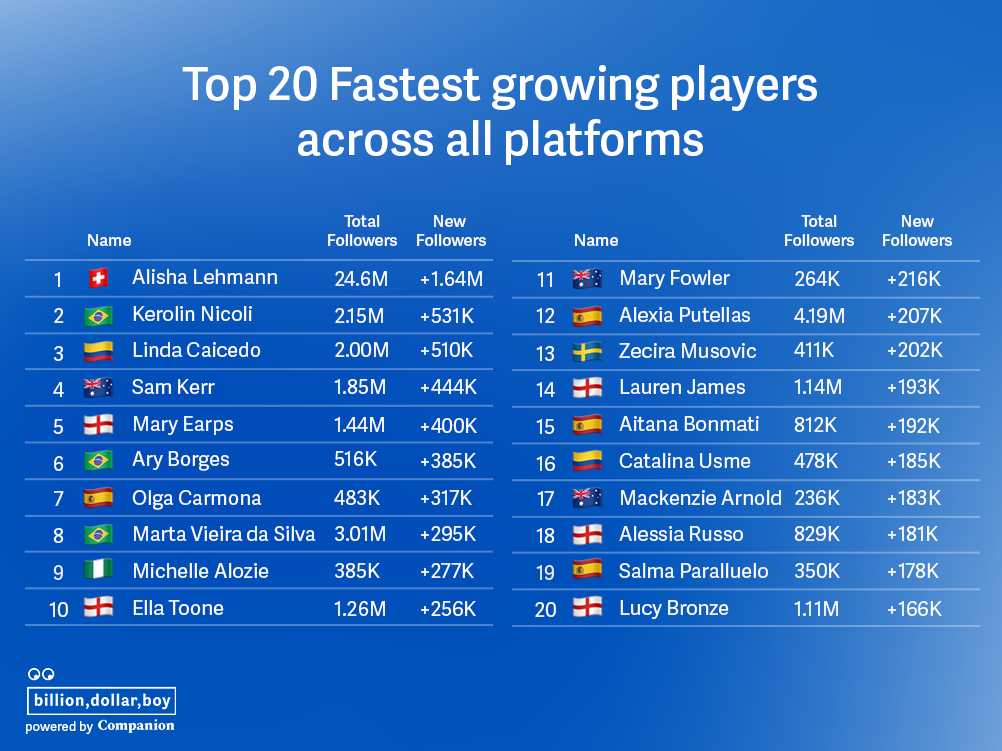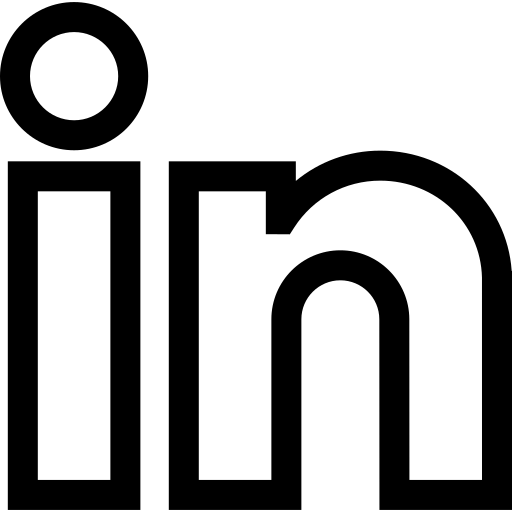Over the last month, the world closely followed the intense football competition – the Women’s World Cup 2023. Yet, for those immersed in influencer marketing, the success of players on social media generates more interest than their game performance.
Companion and Billion Dollar Boy launched an initiative aimed at tracking players’ social media growth during the tournament. We’ve got great insights and identified potential best candidates for brand collaborations in the upcoming season.
The Influence of Footballers
The popularity of football players has transcended the field, making them extremely appealing for brand campaigns. While they already earn significant amounts of money from playing football, some of them make even more as influencers.
Cristiano Ronaldo earns nearly $2 million per post on his social media, equivalent to a monthly salary at Manchester United. A sponsored post on Lionel Messi’s Instagram costs over $1 million. Neymar charges $585,000 for a single mention.
Historically, female footballers have earned less than their male counterparts for their on-pitch achievements. A primary reason behind this inequality is that men’s football attracts a larger fan base, making it easier for clubs to generate higher revenues and consequently offer better wages.
This also explains the disparity in follower counts between male and female footballers. The most followed male athlete, Cristiano Ronaldo, boasts over 600 million followers on Instagram – a record-breaking figure that positions him as the world’s most followed person. On the other hand, Alisha Lehmann, the most followed female athlete, has 15 million followers and commands smaller fees for collaborations. However, considering the growing focus of influencer marketing on niche influencers, it’s highly likely that brands would prefer to collaborate with less-followed but more specialized influencers with highly engaged communities. In this regard, the players of WWC 2023 align perfectly with this criterion!
The Social Media Score of Women’s World Cup 2023
Throughout the WWC 2023, we utilized the Companion tool to monitor players’ social media accounts and track their growth over the tournament. In total, we tracked 736 players across 1,282 accounts spanning Instagram, TikTok, X (formerly Twitter), and YouTube.
Instagram dominated the landscape, with players collectively gaining 12.5 million new followers—out of the total 15.6 million new followers across all tracked platforms.
Followers Growth
While the number of followers isn’t the sole measure of influence on social media, we can’t disregard the pace and extent of growth exhibited by footballers during the tournament. Audience growth indicates that WWC drew more interest to these players, which translated into measurable outcomes in the form of new followers – people who were previously unaware of them or had no reason to follow.

Notably, forwards dominate the rankings, with 10 out of the top 20 most followed players occupying forward positions. Given this trend, we opted to identify the 11 fastest-growing players in a specific formation, resulting in the “Influence XI.” This lineup includes the top 3 forwards, 4 midfielders, 3 defenders, and a leading goalkeeper.

Across all the platforms we tracked, the England squad achieved the highest collective increase in follower count, gaining 2.2 million followers over the course of the tournament. Other teams that ranked in the top 5 for the fastest growth were Brazil (+1.98 million), Australia (+1.83 million), Switzerland (+1.7 million), and Colombia (+1.68 million).
Factors Affecting Follower Growth
As we closely monitored spikes in players’ audience sizes, we discerned a correlation between initial social media standings, on-pitch activity, and subsequent follower growth.
- Initial audience size – strong correlation. Players with larger followings generally found it easier to grow their follower count, relative to their starting point. On average, for every 1,000 followers a player began with, they gained over 60 new followers.
- Minutes played – medium correlation. Players who spent more time on the pitch experienced larger exposure, which translated into audience growth. On average, players could attract 85 new Instagram followers per minute played.
- Goals scored – slight correlation. We found that scoring a goal typically resulted in an average increase of 20,000 new Instagram followers.
Individual player stories that attracted audience interest:
- Michelle Alozie of Nigeria doubled her audience in the days following a red card incident where England’s star player, Lauren James, fouled her late in a game. Interestingly, in that same period, Lauren James experienced the fastest growth among England players, despite being suspended for 2 games.
- Australia’s star Sam Kerr attracted attention due to a calf injury sustained during training on the tournament’s opening day. After much speculation, she finally made a late appearance in the Round of 16. She subsequently played a crucial role in the second half against France, contributing to a tense penalty shoot-out victory.
- Nouhaila Benzina became the first player to wear a hijab at the World Cup. She gained 36,000 followers to her existing 84,000 followers.
- Katie McCabe’s direct goal from a corner kick led to a gain of 76,000 followers, elevating her total to 283,000.
- Asisat Oshoala, the first Nigerian player to score in three separate Women’s World Cup editions. She amassed 100,000 followers to her existing 1.1M followers.
- Sarina Bolden of the Philippines secured the only goal in the first-ever World Cup Game for her country, increasing her followers by 7,000.
- Olga Carmona gained 40,000 followers between scoring a goal and the final whistle, surging from 129,000 to 169,000.
Engagement Rate
The most engaging content was produced by Mary Earps, England’s goalkeeper, following their lose to Spain in the final match of the tournament. This Instagram post garnered 274,828 likes and 10,338 comments.

Another noteworthy piece of content comes from Linda Caicedo. It’s a TikTok carousel, posted after Nigeria’s exit from WWC.
Interestingly, losses seemed to resonate more with the audience than victories.
Earning Potential
After the WWC, players can command an average of £1,214 per sponsored Instagram post. This is an equivalent being how much they could earn if they were based in UK. Purchasing power would be at play in other countries.
This additional income can significantly supplement players’ earnings. Especially considering reports indicating that the average WSL (Women’s Super League) player earns between £25,000 – £27,000 annually.
Only a select few players can demand over £10,000 per Instagram post.

In Conclusion
It was immensely enjoyable to track players as they achieved remarkable success on social media. We commend female footballers, for their on-pitch triumphs and the growth in their popularity.
Our research underscores the immense potential of WWC players for brand collaborations, making them highly worthy of attention when selecting influencers for future sports campaigns.
Women’s football continues to grow in stature and provides unique sponsorship deals for brands and players that the men’s game simply can’t achieve.
If you’re interested in monitoring your influencer marketing campaign with the same level of detail as The Social Score, we’re happy to assist you! Complete this form to get in touch with Companion.


